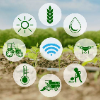The integration of the Internet of Things (IoT) in smart agriculture has transformed farming practices by enabling real time monitoring, data-driven decision making, and automation. However, ensuring reliable connectivity in diverse agricultural environments remains a critical challenge. This paper analyzes the performance trade offs between Low Power Wide Area Networks (LPWAN), specifically LoRaWAN, NBIoT, and Sigfox and cellular networks (4G and 5G) in agricultural applications. Beyond a comprehensive literature review, this study evaluates hybrid LPWAN and 5G architectures that integrate the strengths of both network types to enhance cost-efficiency and connectivity reliability. Using real-world case studies, the findings demonstrate that hybrid LPWAN and 5G models can reduce connectivity costs by up to 30% while significantly improving network reliability in remote agricultural settings. This work provides actionable recommendations for selecting optimal IoT connectivity solutions based on agricultural requirements and proposes future research directions to further optimize IoT infrastructure in smart farming.
翻译:暂无翻译





